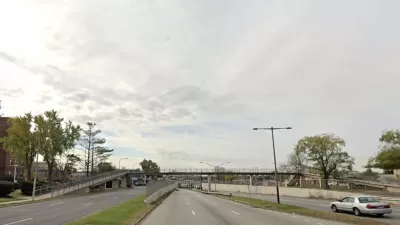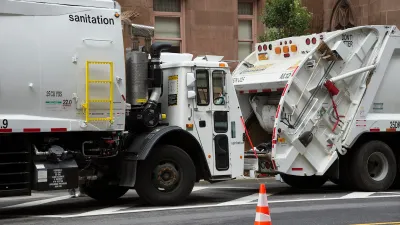Pedestrian safety ratings for cars, drunk driving detection tech, and better headlights—these are just a handful of the automobile safety improvements that will benefit pedestrians as a result of the Infrastructure Investment and Jobs Act.

By now you’ve probably heard: Congress passed the $1.2 trillion bipartisan infrastructure bill, known officially as the Infrastructure Investment and Jobs Act (IIJA).
The package is a little bit of a mixed bag for walking, with some additional safety funding (yay!) and more local control and funding opportunities (yay!) and also a whole lot of new money for highways (boo!). Regardless, we at America Walks are very excited about a couple provisions that promise to finally hold automakers more accountable for keeping pedestrians safe.
Buried within the historic spending package are new rules that will for the first time require car makers to consider the impacts of vehicle designs on pedestrian safety. This is long overdue and something that has been lacking even as U.S. pedestrian deaths have soared to 45-year highs in the last few years .
Here are the highlights of the vehicle safety measures:
1) Cars (and trucks) will receive ratings (on the five-star rating system) on how safe they are for pedestrians.
Even though we know certain cars—namely SUVs and large trucks—can be many times more deadly to pedestrians than smaller cars, these kinds of safety impacts have never been incorporated into our five-star vehicle safety rating system into the United States. Buyers are not even informed they are purchasing a vehicle that may be disproportionately likely to kill someone who is walking.
But thanks to the infrastructure bill, that’s about to change. The bill requires New Car Assessment Program (NCAP)—the United States’ five-star vehicle safety rating system—to be overhauled and that ratings for "vulnerable road users" (pedestrians and cyclists) be added.
That automakers making dangerous vehicles would have to disclose that information is a huge win for pedestrian safety and would bring the United States in line with peer nations in Europe, who have done this for years.
2) Carmakers will be required to design hoods and bumpers to reduce injuries to pedestrians.
Even more exciting: U.S. DOT is instructed to develop standards for hoods and bumpers designed to reduce injuries to vulnerable road users—pedestrians and cyclists—and present those to Congress within two years.
Automakers have used principles of crash physics to improve safety inside cars a lot over the last few decades (think airbags and padded steering wheels). But we haven’t yet applied those same techniques to the front end of cars, where they could save and protect pedestrians and cyclists (unlike some of our peers in Europe).
In 2016, before his death, famous consumer advocate Clarence Ditlow said, "pedestrian protection is one of the final frontiers of vehicle safety," but that automakers were reluctant to address it because it effects the "look" of vehicles.
With some 6,300 pedestrians losing their lives a year, this reform can’t happen soon enough.
3) Automatic emergency braking will become standard
The infrastructure bill will require commercial trucks to come with crash avoidance technology—like automatic emergency braking (AEB). AEB technology has the potential to save a lot of lives and reduce injuries. The Insurance Institute for Highway Safety estimates that it could eliminate about half of front-to-rear crashes. (Automakers have signed a voluntary agreement to make automatic emergency braking standard on all new vehicles by next year.)
But without government standards, these technologies will not live up to their potential. Which is why it is great that the infrastructure bill requires, after one year, for performance test criteria for "crash avoidance technologies" to be developed. This would include AEB in addition to emerging technology like automatic pedestrian detection and ensure they’re up to a usable standard.
There is great potential in these technologies. A combination of AEB, forward collision and lane departure warnings was associated with a 35 percent decrease in pedestrian crash claims by drivers of specially equipped Subarus in an Insurance Institute for Highway Safety (IIHS) study. But right now technologies like automatic pedestrian detection aren't living up to their promise in part because of lack of government standards.
4) Cars will be required to come equipped with drunk driving detection
Here’s another really exciting change: The bill contains a requirement that all cars be equipped with passive drunk driving detection. This means that vehicles will be able to detect if a driver is drunk and would not allow them to drive.
About 9,400 Americans are killed every year by drunk drivers. For far too long the United States has been too permissive about intoxicated driving and out of step with international peers. This measure has the potential to save a lot of lives.
5) It will require cars to have better headlights
Put this one under boring but important, because about three-quarters of fatal pedestrian crashes happen at night. The IIJA will require standards to ensure headlights provide adequate lighting—adapting to lighting conditions—within two years.
As far back as Ralph Nader’s Unsafe at Any Speed, the lack of innovation on headlight technology has been singled out as a safety problem. Cities and suburbs still need to think carefully about their lighting and visibility at night—but in the meantime, this should help things across the board.
In conclusion…
America Walks wants to congratulate the groups that fought for these important reforms, like the League of American Bicyclists, the Insurance Institute for Highway Safety, Advocates for Highway and Auto Safety, and many others. We’ll be tracking progress on these over the coming years and working to inform our followers of any opportunities to influence the process in the defense of pedestrians.
A big thank you to Senators Ed Markey (D-Mass.) and Richard Blumenthal (D-Conn.) who helped lead the charge for these life-saving reforms.
Angie Schmitt is the author of Right of Way: Race Class and the Silent Epidemic of Pedestrian Deaths in America, which was published by Island Press in 2020. She is the founding principal at 3MPH Planning and Consulting.
Mike McGinn is the executive director of America Walks. He was formerly mayor of the city of Seattle.

Planetizen Federal Action Tracker
A weekly monitor of how Trump’s orders and actions are impacting planners and planning in America.

Trump Administration Could Effectively End Housing Voucher Program
Federal officials are eyeing major cuts to the Section 8 program that helps millions of low-income households pay rent.

The 120 Year Old Tiny Home Villages That Sheltered San Francisco’s Earthquake Refugees
More than a century ago, San Francisco mobilized to house thousands of residents displaced by the 1906 earthquake. Could their strategy offer a model for the present?

Texas Bill Would Ban Road Diets, Congestion Pricing
A Texas state senator wants to prevent any discussion of congestion pricing and could suspend existing bike lane and sidewalk projects.

USDOT Threatens to Pull New York Highway Funding
The Trump administration wants the state to kill New York City’s congestion pricing program despite its demonstrated success.

LA’s Tree Emergency Goes Beyond Vandalism
After a vandal destroyed dozens of downtown LA trees, Mayor Karen Bass vowed to replace them. Days later, she slashed the city’s tree budget.
Urban Design for Planners 1: Software Tools
This six-course series explores essential urban design concepts using open source software and equips planners with the tools they need to participate fully in the urban design process.
Planning for Universal Design
Learn the tools for implementing Universal Design in planning regulations.
Ada County Highway District
Clanton & Associates, Inc.
Jessamine County Fiscal Court
Institute for Housing and Urban Development Studies (IHS)
City of Grandview
Harvard GSD Executive Education
Toledo-Lucas County Plan Commissions
Salt Lake City
NYU Wagner Graduate School of Public Service





























